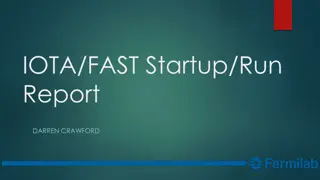
Java NIO: Channels, Buffers, and Usage
Learn about Java NIO Channels and Buffers, their implementations, and basic usage for efficient data reading and writing in Java programming. Explore the concepts of flip, capacity, position, and limit to optimize your code.
Uploaded on | 1 Views
Download Presentation

Please find below an Image/Link to download the presentation.
The content on the website is provided AS IS for your information and personal use only. It may not be sold, licensed, or shared on other websites without obtaining consent from the author. If you encounter any issues during the download, it is possible that the publisher has removed the file from their server.
You are allowed to download the files provided on this website for personal or commercial use, subject to the condition that they are used lawfully. All files are the property of their respective owners.
The content on the website is provided AS IS for your information and personal use only. It may not be sold, licensed, or shared on other websites without obtaining consent from the author.
E N D
Presentation Transcript
Java NIO Channel Java NIO Channels are similar to streams with a few differences: You can both read and write to a Channels. Streams are typically one-way (read or write). Channels can be read and written asynchronously. Channels always read to, or write from, a Buffer. As mentioned above, you read data from a channel into a buffer, and write data from a buffer into a channel. Here is an illustration of that:
Java NIO Channel Here are the most important Channel implementations in Java NIO: FileChannel - reads data from and to files DatagramChannel - can read and write data over the network via UDP. SocketChannel - can read and write data over the network via TCP. ServerSocketChannel - allows you to listen for incoming TCP connections, like a web server does. For each incoming connection a SocketChannel is created.
Java NIO Buffer Java NIO Buffers are used when interacting with NIO Channels. As you know, data is read from channels into buffers, and written from buffers into channels. A buffer is essentially a block of memory into which you can write data, which you can then later read again. This memory block is wrapped in a NIO Buffer object, which provides a set of methods that makes it easier to work with the memory block.
Java NIO Buffer Basic Buffer Usage Using a Buffer to read and write data typically follows this little 4-step process: 1. Write data into the Buffer 2. Call buffer.flip() 3. Read data out of the Buffer 4. Call buffer.clear() or buffer.compact()
Java NIO Buffer When you write data into a buffer, the buffer keeps track of how much data you have written. Once you need to read the data, you need to switch the buffer from writing mode into reading mode using the flip() method call. In reading mode the buffer lets you read all the data written into the buffer. Once you have read all the data, you need to clear the buffer, to make it ready for writing again. You can do this in two ways: By calling clear() or by calling compact(). The clear() method clears the whole buffer. The compact() method only clears the data which you have already read. Any unread data is moved to the beginning of the buffer, and data will now be written into the buffer after the unread data.
Java NIO Buffer Buffer Capacity, Position and Limit A buffer is essentially a block of memory into which you can write data, which you can then later read again. This memory block is wrapped in a NIO Buffer object, which provides a set of methods that makes it easier to work with the memory block. A Buffer has three properties you need to be familiar with, in order to understand how a Buffer works. These are: capacity position Limit The meaning of position and limit depends on whether the Buffer is in read or write mode. Capacity always means the same, no matter the buffer mode.
Java NIO Buffer Buffer Capacity, Position and Limit Here is an illustration of capacity, position and limit in write and read modes. The explanation follows in the sections after the illustration.
Java NIO Buffer Buffer Capacity, Position and Limit Capacity - Being a memory block, a Buffer has a certain fixed size, also called its "capacity". You can only write capacity bytes, longs, chars etc. into the Buffer. Once the Buffer is full, you need to empty it (read the data, or clear it) before you can write more data into it. Position - When you write data into the Buffer, you do so at a certain position. Initially the position is 0. When a byte, long etc. has been written into the Buffer the position is advanced to point to the next cell in the buffer to insert data into. Position can maximally become capacity - 1. When you read data from a Buffer you also do so from a given position. When you flip a Buffer from writing mode to reading mode, the position is reset back to 0. As you read data from the Buffer you do so from position, and position is advanced to next position to read.
Java NIO Buffer Buffer Capacity, Position and Limit Limit - In write mode the limit of a Buffer is the limit of how much data you can write into the buffer. In write mode the limit is equal to the capacity of the Buffer. When flipping the Buffer into read mode, limit means the limit of how much data you can read from the data. Therefore, when flipping a Buffer into read mode, limit is set to write position of the write mode. In other words, you can read as many bytes as were written (limit is set to the number of bytes written, which is marked by position). Buffer Types - Java NIO comes with the following Buffer types: ByteBuffer MappedByteBuffer CharBuffer DoubleBuffer FloatBuffer IntBuffer LongBuffer ShortBuffer As you can see, these Buffer types represent different data types. In other words, they let you work with the bytes in the buffer as char, short, int, long, float or double instead.
Java NIO Files The Java NIO Files class (java.nio.file.Files) provides several methods for manipulating files in the file system. This Java NIO Files tutorial will cover the most commonly used of these methods. The Files class contains many methods, so check the JavaDoc too, if you need a method that is not described here. The Files class just might have a method for it still. The java.nio.file.Files class works with java.nio.file.Path instances, so you need to understand the Path class before you can work with the Files class.
Java NIO Files Files.exists() The Files.exists() method checks if a given Path exists in the file system. It is possible to create Path instances that do not exist in the file system. For instance, if you plan to create a new directory, you would first create the corresponding Path instance, and then create the directory. Since Path instances may or may not point to paths that exist in the file system, you can use the Files.exists() method to determine if they do (in case you need to check that). Files.createDirectory() The Files.createDirectory() method creates a new directory from a Path instance.
Java NIO Files Files.copy() The Files.copy() method copies a file from one path to another. It is possible to force the Files.copy() to overwrite an existing file with StandardCopyOption.REPLACE_EXISTING. Files.move() The Java NIO Files class also contains a function for moving files from one path to another. Moving a file is the same as renaming it, except moving a file can both move it to a different directory and change its name in the same operation. Yes, the java.io.File class could also do that with its renameTo() method, but now you have the file move functionality in the java.nio.file.Files class too.
Java NIO Files Files.delete() The Files.delete() method can delete a file or directory. Files.walkFileTree() The Files.walkFileTree() method contains functionality for traversing a directory tree recursively. The walkFileTree() method takes a Path instance and a FileVisitor as parameters. The Path instance points to the directory you want to traverse. The FileVisitor is called during traversion.


